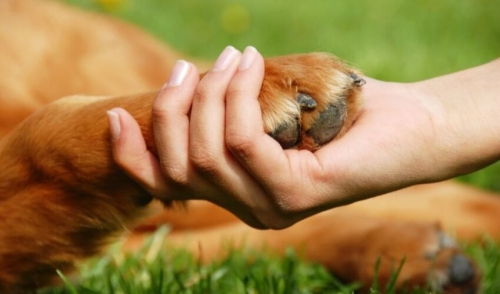{article.name}
Protect Your Dog’s Paws From Hot Pavement

- Share this:
- Share on Facebook
- Pin on Pinterest
- Tweet on Twitter
Walking your dog is ideal exercise, reinforces training, and helps you bond with your pet, and summer is a great time for long, rambling walks. If you are walking on hot asphalt and pavement, however, your dog may be getting something you didn’t bargain for – painful burns and blisters. Fortunately, it is easy to protect your dog’s paws from hot pavement without giving up summer walks.
How Hot is Hot?
Quirky demonstrations of frying eggs, baking cookies, or grilling steaks on a sidewalk can be a dramatic way to understand how hot surfaces can get in the summer, but they don’t accurately measure the surface temperature or convey how quickly your dog’s paws can be burned just by standing or walking. Furthermore, because surfaces, particularly asphalt and concrete, will absorb heat, they can actually be much hotter than the surrounding air temperature, so even if a summer day isn’t outrageously hot, your pet’s paws can still be at risk. For example, when the outdoor temperature is a sunny 80 degrees Fahrenheit, an asphalt surface can be as hot as 125 degrees Fahrenheit, and can cause painful and dangerous burns in as little as 60 seconds.
Of course, most pet owners don’t carry surface thermometers and aren’t equipped to precisely measure surface heat before a friendly walk. A quick rule-of-thumb test is to put your hand down on the surface and hold it there for 7-10 seconds. If you are unable to keep your hand on the surface that long without discomfort, then it is too hot for your dog’s paws.
It is also important to remember that all surfaces will heat up in the summer. Not only are asphalt roads and concrete sidewalks potentially too hot for your pet, but the metal bed of a pickup truck, the paved surfaces of tennis courts and running tracks, artificial turf, sunny docks and piers, sandy beaches, and brick walkways can all be dangerously hot and should be treated with caution.
Protecting Paws From Hot Surfaces
There are many ways to protect your dog’s sensitive paws from hot surfaces in the summer, and with simple adjustments, your four-legged friend can enjoy plenty of exercise without painful paws.
- Keep ON the Grass Natural grass is the coolest surface for a dog’s feet in summer, and it is also full of rich and enticing smells to explore. Instead of walking on harsher, hotter surfaces, walk through a park or allow your dog to walk on grass rather than concrete or asphalt. This may mean you have to drive to a suitable park or natural area where dogs are welcomed, and it may be necessary to carry your dog across a parking lot or other hot surface to stay safe before playtime.
- Walk at Cooler Times If your only walking routes are filled with potentially hot surfaces, walk your dog at the coolest times of day when those surfaces will not be radiating as much heat. Early morning before the sun has risen is best, because not only will the air temperature be at its coolest, but the surface has also given off stored heat throughout the night and will be much cooler. Late evening walks after sunset are also an option, and the later the walks are, the cooler the surfaces will be.
- Follow a Shady Route Whenever possible, walk a route that includes plenty of deep shade, especially over potentially harsh and hot surfaces. This will cut the sun’s rays and keep surfaces from heating up as much, and will cool the air temperature and minimize the risk of sunburn besides. To keep in the shade, switch street sides to take advantage of trees or buildings that provide the darkest shade for the coolest steps.
- Consider Protective Footgear Our shoes protect our feet from hot surfaces, and appropriate gear can also protect your dog’s paws. Thick-soled booties or boots are best, and they should have some ventilation around the ankles to help keep your pet’s feet cool, as dogs sweat through the pads on their feet. Use the proper size for your dog’s feet and check that the gear fits snugly, and take time to get your dog used to wearing paw protection before summer hits.
- Condition Your Dog’s Paws Building up the calluses on your dog’s paw pads is a great way to help them resist summer heat. Dogs that exercise on gravel, concrete, and asphalt throughout the year will have better resistance to harsher conditions. While it is still best to keep your dog off the hottest surfaces entirely, if you’ve exercised your dog well during the spring and early summer, gradually building up their paw pads and tolerance, they will be better equipped to continue great walks as the summer heats up.
- Moisturize Paw Pads If your dog’s paws are cracked or scratched, they can be much more sensitive to heat stress and burns. Using pet-friendly waxes, balms, or lotions is a great way to soothe your pet’s paws and provide a layer of protection against hot surfaces. Take care to use products according to the directions, however, and reapply them regularly for maximum protection.
- Opt for Alternative Exercise On the very hottest days or when there is no option for cooler walking surfaces, it may be best to choose alternative exercises to keep your dog active. Stay in the yard for a rigorous game of fetch, tag, or tug-of-war, or try indoor games such as hide-and-seek. By changing activities and avoiding walks on too-hot surfaces, you will also provide better mental stimulation to improve your pet’s well-being.
Know the Signs of Damaged Paws
Despite taking precautions to protect your dog from hot pavement, it is still wise to check their paws regularly for damage and injuries. If your dog is refusing to walk or is limping, quickstepping, or licking or chewing on its paws, it may already be injured. Burned paw pads can look darker than their typical color, or may show redness, blistering, or peeling. Flush your dog’s paws with cool water or apply a cool compress, and seek emergency veterinary care as soon as possible to treat burns and prevent infections.
With care, you can protect your dog’s paws from hot asphalt, concrete, and other summer surfaces, but still enjoy the time you spend together walking, playing, and exercising.

Comments